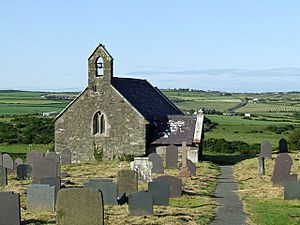St Maethlu's Church, Llanfaethlu facts for kids
Quick facts for kids St Maethlu's Church |
|
|---|---|
 |
|
| Country | Wales, United Kingdom |
| Denomination | Church in Wales |
| Architecture | |
| Heritage designation | Grade II* |
| Designated | 4 May 1971 |
| Architectural type | Church |
| Style | Medieval |
St Maethlu's Church is a very old church in the village of Llanfaethlu, located on Anglesey island in Wales. This church was built a long time ago, in the 1400s. It is part of a group of churches in the Bro Padrig area. The church building was updated in the early 1900s. On May 4, 1971, it was officially recognized as a special building. This means it is a "Grade II*" listed building, important for its history.
Contents
Who is Saint Maethlu?
This church is named after a Christian saint called Maethlu. He was known as Maethlu the Confessor. People believe he started a religious community. This community was located about three-quarters of a mile south of where the church stands today.
The Church Building's History
St Maethlu's Church was first built in the 1400s. The main part of the church, called the nave, was built then. The entrance porch, with its old stone seats, also dates from this time. The church walls are made of rough stone. Its roof is covered with slate tiles.
Special Features of the Church
At the west end of the roof, there is a small tower for the bell. The bell itself was made in 1760. The nave has three sections, called bays. It is built in a style known as Perpendicular. You can still see two original windows from the 1400s on the south side. Each window has a square frame. Inside, there are two lights, which are openings shaped like five-leaf clovers.
Inside the Church
On the north wall, there are beautiful memorials. These are made of bronze and marble. They date from the 1700s and 1800s. A part of the church called the chancel was added in 1874. The entire building was carefully restored in the early 1900s.
Why is St Maethlu's Church a Listed Building?
St Maethlu's Church became a "Grade II*" listed building on May 4, 1971. This means it is a very important historical building. It is a great example of a small country church. Most of it was built in the 1400s. It still has its original parts and details. The church also has a wonderful collection of memorials. Some of these memorials are from the 1500s and 1600s.
Keeping Records of the Church
The Royal Commission on the Ancient and Historical Monuments of Wales keeps records of this church. They have many details about its history and architecture. These records include digital photos of the church, both inside and out. They also have drawings, color slides, and special site files.

